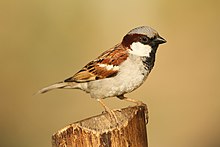
Back Neoaves Afrikaans طيور جديدة Arabic طيور جديده ARZ Neoaves AST Neoaus Catalan Neoaves Czech Neoaves Welsh Neoaves Esperanto Neoaves Spanish Neoaves Basque
| Neoavians Temporal range: Paleocene – Holocene, Possible Late Cretaceous origin based on molecular clock[2][3]
| |
|---|---|

| |
| Great crested grebe (Podiceps cristatus) | |

| |
| House sparrow (Passer domesticus) | |
| Scientific classification | |
| Domain: | Eukaryota |
| Kingdom: | Animalia |
| Phylum: | Chordata |
| Class: | Aves |
| Infraclass: | Neognathae |
| Clade: | Neoaves Sibley et al., 1988 |
| Clades | |
Neoaves is a clade that consists of all modern birds (Neornithes or Aves) with the exception of Palaeognathae (ratites and kin) and Galloanserae (ducks, chickens and kin).[4] Almost 95% of the roughly 10,000 known species of extant birds belong to the Neoaves.[5]
The early diversification of the various neoavian groups occurred very rapidly around the Cretaceous–Paleogene extinction event,[6][7] and attempts to resolve their relationships with each other have resulted initially in much controversy.[8][9]
- ^ Ksepka, Daniel T.; Stidham, Thomas A.; Williamson, Thomas E. (25 July 2017). "Early Paleocene landbird supports rapid phylogenetic and morphological diversification of crown birds after the K–Pg mass extinction". Proceedings of the National Academy of Sciences. 114 (30): 8047–8052. Bibcode:2017PNAS..114.8047K. doi:10.1073/pnas.1700188114. PMC 5544281. PMID 28696285.
- ^ Kuhl., H.; Frankl-Vilches, C.; Bakker, A.; Mayr, G.; Nikolaus, G.; Boerno, S. T.; Klages, S.; Timmermann, B.; Gahr, M. (2021). "An unbiased molecular approach using 3'UTRs resolves the avian family-level tree of life". Molecular Biology and Evolution. 38: 108–127. doi:10.1093/molbev/msaa191. PMC 7783168. PMID 32781465.
- ^ Field, Daniel J.; Benito, Juan; Chen, Albert; Jagt, John W. M.; Ksepka, Daniel T. (March 2020). "Late Cretaceous neornithine from Europe illuminates the origins of crown birds". Nature. 579 (7799): 397–401. Bibcode:2020Natur.579..397F. doi:10.1038/s41586-020-2096-0. ISSN 0028-0836. PMID 32188952. S2CID 212937591.
- ^ Jarvis, E. D.; et al. (2014). "Whole-genome analyses resolve early branches in the tree of life of modern birds". Science. 346 (6215): 1320–1331. Bibcode:2014Sci...346.1320J. doi:10.1126/science.1253451. ISSN 0036-8075. PMC 4405904. PMID 25504713.
- ^ Ericson, Per G.P.; et al. (2006). "Diversification of Neoaves: integration of molecular sequence data and fossils" (PDF). Biology Letters. 2 (4): 543–547. doi:10.1098/rsbl.2006.0523. PMC 1834003. PMID 17148284. Archived from the original (PDF) on 2009-03-25. Retrieved 2019-08-29.
- ^ McCormack, J.E.; et al. (2013). "A phylogeny of birds based on over 1,500 loci collected by target enrichment and high-throughput sequencing". PLOS ONE. 8 (1): e54848. arXiv:1210.1604. Bibcode:2013PLoSO...854848M. doi:10.1371/journal.pone.0054848. PMC 3558522. PMID 23382987.
- ^ Claramunt, S.; Cracraft, J. (2015). "A new time tree reveals Earth history's imprint on the evolution of modern birds". Sci Adv. 1 (11): e1501005. Bibcode:2015SciA....1E1005C. doi:10.1126/sciadv.1501005. PMC 4730849. PMID 26824065.
- ^ Mayr, G (2011). "Metaves, Mirandornithes, Strisores and other novelties - a critical review of the higher-level phylogeny of neornithine birds". J Zool Syst Evol Res. 49: 58–76. doi:10.1111/j.1439-0469.2010.00586.x.
- ^ Matzke, A. et al. (2012) Retroposon insertion patterns of neoavian birds: strong evidence for an extensive incomplete lineage sorting era Mol. Biol. Evol.